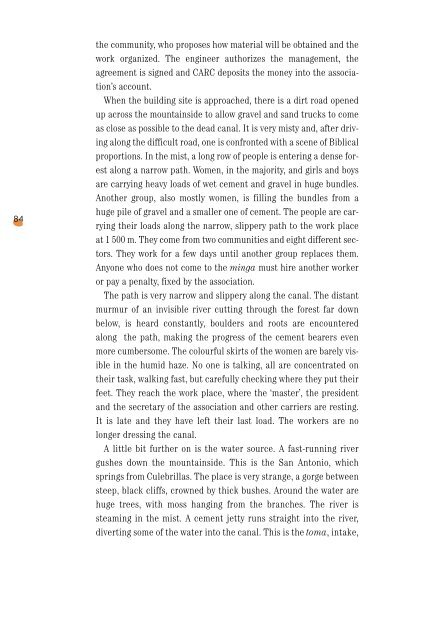mishqui-yacu, sweet water - IFAD
mishqui-yacu, sweet water - IFAD
mishqui-yacu, sweet water - IFAD
You also want an ePaper? Increase the reach of your titles
YUMPU automatically turns print PDFs into web optimized ePapers that Google loves.
84<br />
the community, who proposes how material will be obtained and the<br />
work organized. The engineer authorizes the management, the<br />
agreement is signed and CARC deposits the money into the association’s<br />
account.<br />
When the building site is approached, there is a dirt road opened<br />
up across the mountainside to allow gravel and sand trucks to come<br />
as close as possible to the dead canal. It is very misty and, after driving<br />
along the difficult road, one is confronted with a scene of Biblical<br />
proportions. In the mist, a long row of people is entering a dense forest<br />
along a narrow path. Women, in the majority, and girls and boys<br />
are carrying heavy loads of wet cement and gravel in huge bundles.<br />
Another group, also mostly women, is filling the bundles from a<br />
huge pile of gravel and a smaller one of cement. The people are carrying<br />
their loads along the narrow, slippery path to the work place<br />
at 1 500 m. They come from two communities and eight different sectors.<br />
They work for a few days until another group replaces them.<br />
Anyone who does not come to the minga must hire another worker<br />
or pay a penalty, fixed by the association.<br />
The path is very narrow and slippery along the canal. The distant<br />
murmur of an invisible river cutting through the forest far down<br />
below, is heard constantly, boulders and roots are encountered<br />
along the path, making the progress of the cement bearers even<br />
more cumbersome. The colourful skirts of the women are barely visible<br />
in the humid haze. No one is talking, all are concentrated on<br />
their task, walking fast, but carefully checking where they put their<br />
feet. They reach the work place, where the ‘master’, the president<br />
and the secretary of the association and other carriers are resting.<br />
It is late and they have left their last load. The workers are no<br />
longer dressing the canal.<br />
A little bit further on is the <strong>water</strong> source. A fast-running river<br />
gushes down the mountainside. This is the San Antonio, which<br />
springs from Culebrillas. The place is very strange, a gorge between<br />
steep, black cliffs, crowned by thick bushes. Around the <strong>water</strong> are<br />
huge trees, with moss hanging from the branches. The river is<br />
steaming in the mist. A cement jetty runs straight into the river,<br />
diverting some of the <strong>water</strong> into the canal. This is the toma, intake,
















